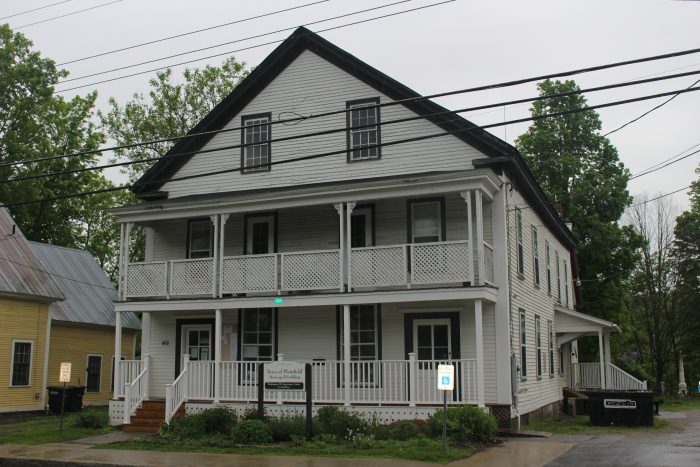
SMALL GOVERNMENT: According to the Agency of Natural Resources, small municipal governments should be aware of all resources available to them including working with other government agencies. The Plainfield town offices are shown here.
The seventh annual Municipal Day workshop is touring the state to encourage employees at various levels of government to work together and use more efficient tactics — and to think about climate change.
The project, sponsored by the Agency of Natural Resources, includes a focus on getting local governments to implement climate change policies.
Municipality Day is an opportunity for representatives of municipalities to get together with state officials and participate in workshops that help with education and training in government. Topics include grants, river corridors, automated wood heat, recycling regulations, mapping tools for environmental planning and more. Participants often include planning and zoning commissioners, town managers and selectboard members.
Shaun Fielder, town manager for Hardwick, told True North his town is participating this year. He said it’s a good opportunity to interact with other state officials that you might not otherwise cross paths with.
“What they are trying to do is make sure that you have info about the various programs that they offer and some of the regulatory parameters to work with,” he said.
Fielder said the range of issues covered is broad, addressing such topics as taxes, human resources, the Department of Corrections, water and wastewater infrastructure, permitting parameters, economic development guidance, and more.
Agency of Natural Resources Deputy Secretary Peter Walke described why the agency is sponsoring the event.
“Municipal Day is at the heart of what we as an agency do every day — working with Vermonters to achieve important environmental outcomes together,” he said. “We welcome the opportunity to hear directly from town officials, and I invite you to join us and share your town’s experiences.”
The agenda for the Montpelier edition, to be held Friday, Oct. 25, includes “Vermont’s Ecology and Environment, Web Maps and What You Can Do with Them, Housing Ready Bylaws, Water Quality Funding, Active Forest Management for Towns, and Wetland Regulations.”
It also includes a presentation by state climatologist Lesley-Ann Dupigny-Giroux, who will give a presentation on “the most recent National Climate Assessment and climate change in Vermont at the plenary session,” according to the ANR website.
Climate change policy appears to be embedded within various workshops. For example, among the documents posted on ANR’s website is “Flooding and Your Community,” a guide that includes warnings that climate change is worsening and towns must increase their efforts to mitigate it.
“No town is immune,” it states. “Between 1999 and 2013, 96% of Vermont towns requested assistance 531 times to repair roads, bridges, and buildings that floodwaters damaged. That added up to over $260 million or $19 million each year. And that doesn’t include private property damage. As our climate changes, these numbers will likely get worse, unless we build a better relationship with our rivers and streams.”
Other agenda items delve into futuristic technologies. On the Municipal Day agenda for Rutland is a segment titled “Is your town willing to help bring self-driving cars to Vermont?”
According to the agenda, this presentation will introduce local officials and volunteers to automated vehicle technology and its development and testing around the country, including “Vermont’s automated vehicle testing law and the role of municipalities in the test permit approval process.”
The Rutland agenda also includes 30 minutes for “Vermont Conservation Design and the BioFinder.” BioFinder is a resource available to help determine where land use might endanger protected wildlife.
“It is a tool that identifies features at the landscape and natural community scales that are necessary for maintaining an ecologically functional landscape – a landscape that conserves current biological diversity and allows species to move and shift in response to climate and land-use changes,” the agenda states.
Limiting development to protect nature is woven throughout the workshops. One document introduces participants to the Shoreland Protection Act, which establishes that all development must be at least 250 feet from the mean water level for large bodies of water.
The Montpelier agenda lists a similar item concerning development near wetlands: “Wetlands are everywhere! Over 10% of Vermont is either wetland or adjacent land. The state regulates activities within wetlands and a fifty-foot ‘buffer’ zone around the wetland. When wetlands and buffers cannot be avoided, a state wetland permit may be needed.”
The Essex-Junction agenda will also have its share of shore-line protection content, too, in its “Where Land & Water Meet: Wetland, Shoreland, and Lake Encroachment Regulations” section.
The first day of training begins Oct. 23, in Springfield, Vermont. Registration is still open for a few more days for the other three locations of Rutland, Montpelier and Essex Junction.
Michael Bielawski is a reporter for True North Reports. Send him news tips at bielawski82@yahoo.com and follow him on Twitter @TrueNorthMikeB.


